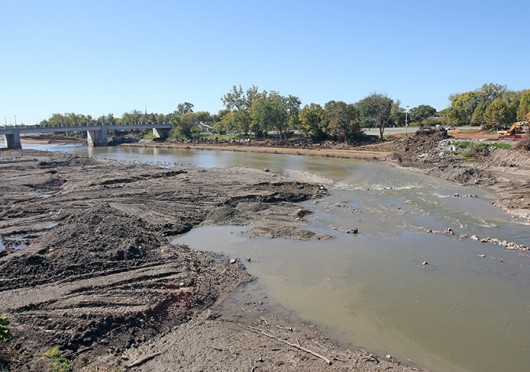
Efforts including fireworks, sirens and lasers are set to take place along the Olentangy River starting March 19 in an attempt to remove geese.
Credit: Shelby Lum / Photo editor
Fireworks, sirens, lasers and pyrotechnics.
These are the sights and sounds that will permeate Ohio State’s campus lining the Olentangy River in an effort to remove pestering geese.
The geese — said to be treating vegetation between Fifth and Lane avenues as an all-you-can-eat buffet — are set to be removed from the area starting Wednesday in order for work on a construction project to be completed.
The potential solution: intermittent loud noises, visual deterrents and physical barriers.
In August 2012, the Olentangy River renovation began with the partial removal of the Fifth Avenue Dam. About one-third of the structure was removed completely, while along the remaining length of the dam, the top two feet of concrete were removed and the rest was covered with soil. The project was estimated in October to be finished by May 31, weather permitting.
George Zonders, a spokesman for the City of Columbus, said previous attempts to deter the geese were unsuccessful, including plastic coyotes and aluminum stakes set up along the river.
“(The geese) figured out those are passive restraints and they treated the (vegetation) seeding as their own personal buffet. To get plant life, we need to take more aggressive measure,” Zonders said. “There’s going to be a continuation of things like mylar tape and ground cover that makes it more difficult for them to walk, but there’s also going to be flashing of lasers, some pyrotechnics and some that make firework-type sounds.”
These methods are scheduled to be employed approximately 30 minutes before sunrise until 30 minutes after sunset. For the first three weeks, the activities are set to happen each day of the week but after that, until December or the “vegetation matures,” the efforts will likely occur just Monday through Friday, according to the OSU release.
Zonders said the effort is an agreement between Columbus city government, the U.S. Department of Agriculture and Evans Landscaping, the company contracted by the government to carry out some of the river construction.
“We received input from USDA that this was the way to go. If you’ve seen the dam removal and the Olentangy River restoration project … the final piece of that puzzle is to reintroduce and get going several native species of plants,” Zonders said. “The reason for those is to prevent erosion … and help filtrate storm water.”
The total cost was $6.9 million, which includes $500,000 in grant funding from the Ohio Environmental Protection Agency, $2 million from Ohio State and $2.1 million from the City of Columbus.
Plastic signing was set to be placed along the river corridor to alert people of what’s happening, the release said.
OSU spokeswoman Liz Cook said OSU is working to generate awareness of the project.
“In that the project is occurring along the banks of the Olentangy River and very visible to the university community, Ohio State is assisting to ensure that faculty, staff and students are aware of the developments,” Cook said in an email.


